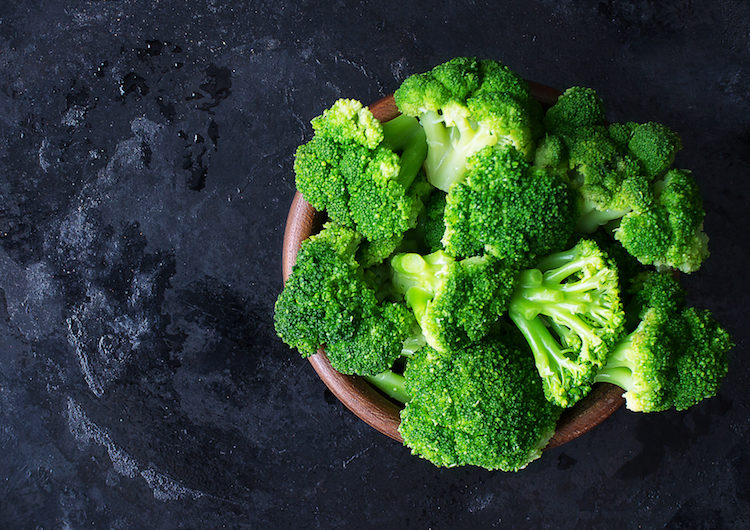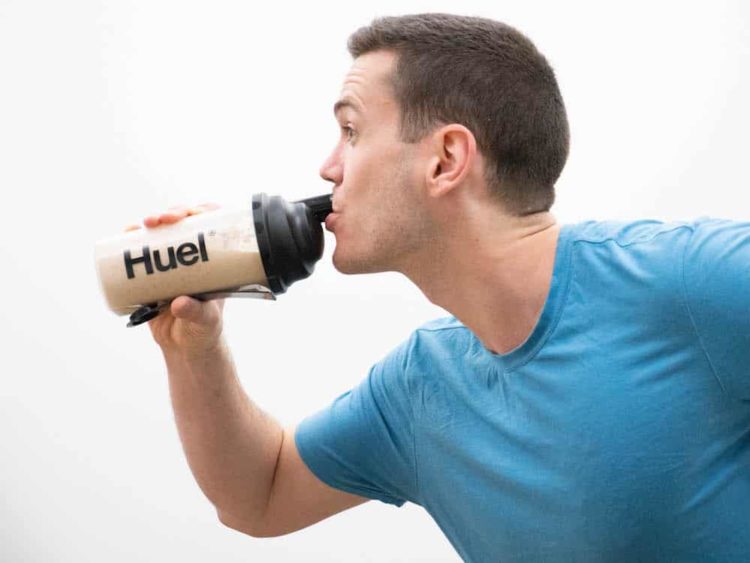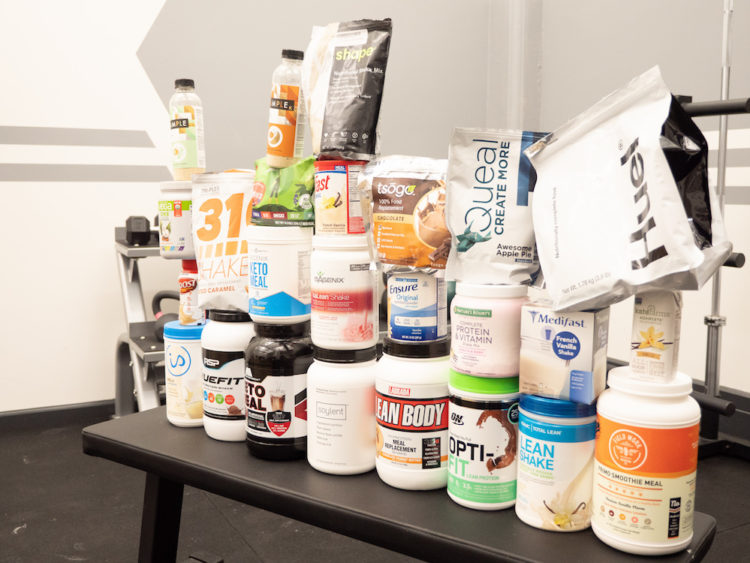There was a very popular meal replacement that was all the rage in 2013 — Soylent, we’re talking about Soylent — whose inventor lived on it for one month straight and said he felt superb. Better skin, better energy levels and above all, more productivity!
The product made headlines for the implication that you can live on nothing but Soylent, although nowadays the company is careful to put a disclaimer on all of their products: “Soylent is not intended to replace every meal, but it can replace any meal.”
That’s the tactic that we take toward meal replacements: that they can be a useful, although not perpetual, replacement for a meal.
Now, we’ve tried dozens and dozens of these supplements to land on our list of best meal replacements, and while there are plenty of crummy options that are low in protein and low in nutrients… some of them are, well, really good.
Our top pick Huel, for example, has 28 vitamins and minerals, a good balance of macronutrients, it’s not too low in calories, and it even provides Omega-3 fatty acids.
So why can’t I just live on this shake alone?
Editor’s note: The content on BarBend is meant to be informative in nature, but it shouldn’t take the place of advice and/or supervision from a medical professional. The opinions and articles on this site are not intended for use as diagnosis, prevention, and/or treatment of health problems. Speak with your physician if you have any concerns.
Meal Replacements and Satiety
“I have seen a study or two on satiety and hunger. They were comparing people eating food and people drinking a smoothie,” says New York-based dietitian Natalie Rizzo, MS, RD. “They found people who have to chew the food feel fuller after chewing, even if it’s the same nutrients and calories.”
This study was published in Hormone and Metabolic Research in 2007, and it did indeed conclude that hunger hormones like ghrelin were affected differently in solid versus liquid food.(1) It concluded that shakes,
led to differential appetitive responses and should not be viewed as dietary equivalents in older adults.
But, well, it’s never that hard to find studies with opposing conclusions. Here are three (2)(3)(4) that said meal replacements “can safely and effectively produce significant weight loss” and may help to manage blood sugar.
This is not medical advice, mind you — talk to a physician before starting a new supplement regimen, especially if you have diabetes. The point is, well, research is conflicting with the appetite stuff. What if you don’t struggle with your appetite? Or you take a fiber supplement, like psyllium husk, that can boost satiety? Or what if you’re not trying to lose weight?
[Related: Micronutrients vs Macronutrients – What Should You Focus On?]
What’s Missing From a Meal Replacement?
What if your meal replacement is really good?
Not something like Slimfast, which has just 2 grams of protein per serving. Let’s say it’s something like Huel, who we promise did not sponsor this article. It’s got a good balance of macros and calories — 500 per adjustable serving with 37 grams of protein, 47 grams of carbs and 16 grams of fat — Omega-3s, and about 30 percent of the recommended daily intake of 28 vitamins and minerals, including uncommon ones like chromium, choline, chloride.
You’ll never make an actual meal with so much of every micronutrient! Why shouldn’t I just take this all day, every day?
Phytochemicals and Antioxidants
“I think that there are some things you’re going to miss out on,” says Rizzo.”There are things you don’t see on the food label that are important, like antioxidants and phytochemicals. Those are plant compounds that have been shown to be really beneficial to heart health and disease risk, things like that.”
Wait a minute. Aren’t macronutrients (protein/carbs/fat) and micronutrients (vitamins/minerals) the only things the government says you need to consume?
“Essentially, every single plant-based food has things like antioxidants and phytochemicals and phytonutrients,” Rizzo explains. “There are thousands of them. The ones we know a lot about are flavonoids, which are usually in the darker colored foods — resveratrol is an example that’s found in reddish colored foods like grapes and berries that may improve heart health.”
Other examples that are just found in broccoli include
- indole-3-carbinol (which may help to balance estrogen(5)
- glucosinolates (which are antiviral and antibacterial)(6)
- isothiocyanates (which may be anti-carcinogenic)(7)

There are tons of other phytonutrients, and a really big benefit many can confer is their antioxidant effect: they may help to combat inflammation.
“Inflammation comes in two different forms,” says Rizzo. “There’s acute, which is short term and something your body will naturally repair itself from, like the effect of a workout or a bruise. But then there’s long term inflammation, which is associated with obesity and chronic disease. If you have inflammation built up in your body for a long period of time, you have a higher risk of developing chronic diseases, and research has found that people who eat more foods with antioxidants and phytochemicals have a lesser chance of getting these sorts of diseases.”
Importantly, antioxidants and phytochemicals are not on any food labels, they’re very hard to measure, and the FDA has not set a recommended daily intake for them.
You’ll live without these things — you’ve probably met people who live without any vegetables at all — but evidence strongly suggests you’ll live better with them.
[Related: The Best Foods and Supplements for Fighting Inflammation]
Digestive Health
Besides phytonutrients, there are other important components to our food that don’t have recommended daily intakes, like digestive enzymes. Proteases, lipases, amylases, these are found in whole foods and help you to better absorb the nutrients you do eat — they help you make the most of your calories.
Add to that prebiotic fiber and probiotic bacteria. They may improve the health of the trillions of bacteria that live in your digestive tract, and those bacteria may exert an effect on not only your nutrient absorption, but your immunity, inflammation, and physical performance.
[Related: Why Probiotics Are Extra Important for Athletes]
What to Look For In a Meal Replacement
So… you kind of just have to eat food.
Meal replacement shakes can have their place but,
- Make sure it has enough calories to replace a meal. There are a lot of 90-calorie “meal replacement” shakes that won’t keep you full. Nobody’s eating a 90-calorie lunch.
- Get one with a good balance of protein, carbs, and fat. Many of them are just protein shakes with added vitamins.
- If you can, find one with ingredients for digestive health. Ample is a good example, here: it contains fiber, prebiotic fiber, and probiotic bacteria, although it’s pretty low in vitamins.
- If possible, find one that isn’t too high in Omega-6 fatty acids, like canola oil. Ample and Huel are both decent options in this regard.
- Eat real food as well.
At least eat a lot of cruciferous vegetables every day. They have links to just about every health benefit under the sun.
Ideally, you’ll get all your nutrients from whole foods but hey, sometimes you get busy. Or lazy. We get it, that’s why we have meal replacements several times a week — but always with some fruits or veggies on the side and with lots of whole foods over the rest of the day.
References
1. Tieken, SM et al. Effects of Solid versus Liquid Meal-replacement Products of Similar Energy Content on Hunger, Satiety, and Appetite-regulating Hormones in Older Adults. Horm Metab Res. 2007 May; 39(5): 389–394.
2. Heymsfield, SB et al. Weight management using a meal replacement strategy: meta and pooling analysis from six studies. Int J Obes Relat Metab Disord . 2003 May;27(5):537-49.
3. Boonyavarakul, A et al. Effects of meal replacement therapy on metabolic outcomes in Thai patients with type 2 diabetes: A randomized controlled trial. Nutr Health . 2018 Dec;24(4):261-268.
4. Kempf, K et al. Individualized Meal Replacement Therapy Improves Clinically Relevant Long-Term Glycemic Control in Poorly Controlled Type 2 Diabetes Patients. Nutrients . 2018 Aug 4;10(8):1022.
5. Auborn, K et al. Indole-3-carbinol is a negative regulator of estrogen. J Nutr . 2003 Jul;133(7 Suppl):2470S-2475S.
6. Melrose, J et al. The Glucosinolates: A Sulphur Glucoside Family of Mustard Anti-Tumour and Antimicrobial Phytochemicals of Potential Therapeutic Application. Biomedicines. 2019 Sep; 7(3): 62.
7. Wu, X et al. Are isothiocyanates potential anti-cancer drugs? Acta Pharmacol Sin. 2009 May; 30(5): 501–512.


